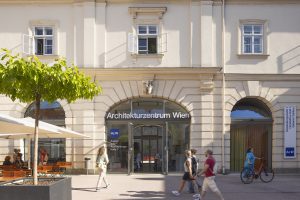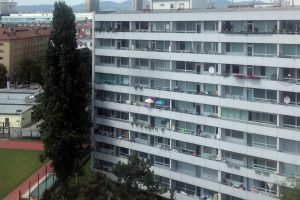Exhibition
From Tableware to a Prefabricated Housing: The Architect and Designer Carl Auböck (1924–1993)

Carl Auböck/Roland Rainer, model home development, garden facade of a unit, Veitingergasse, Vienna, 13th district, Wien 13, 1953–1954
© Architekturzentrum Wien, Collection, photograph: Roland Rainer
As a member of a family dynasty which for some 125 years has produced numerous classics in architecture and the design disciplines, Carl Auböck III contributed to a surge in innovation in postwar Austria.
Marking the hundredth anniversary of his birth and the acquisition of his archive by the Collection, the exhibition offers dual insights – into Auböck’s oeuvre and into Az W’s collection activity. Like a large-format archival box, the exhibition opens up, yielding material from Carl Auböck’s cosmopolitan life and work. Living Archive, our new exhibition series, provides a glimpse of how Az W goes about its work behind the scenes.
In the early 1950s, having completed artisanal apprenticeships and received a degree in architecture from the Vienna University of Technology, Auböck headed to the United States to pursue postgraduate studies at the Massachusetts Institute of Technology (MIT) in Boston. Ahead of other Austrian architects, he became acquainted with proponents of international modernism. When Auböck returned to Vienna, the methods of serial prefabrication of entire buildings and of specialized components he had learned in the United States had an influence on his work in residential architecture. His broad interpretation of the scope of architecture and design spanned from city planning ideas, via construction of single-family homes and housing blocks, to the design of objects of daily use such as cutlery and skiwear. He worked with well-established firms such as Tyrolia, Riedel Glas, and Neuzeughammer Ambosswerk to produce a number of innovative products whose design set new standards in Austria.
The exhibitions subsumed in our Living Archive series provide a platform for collecting activities that are not just a matter of preservation, but also incorporate new approaches and methodologies. The discussion series entitled Out of the Box features persons who encountered Carl Auböck as well as specialists knowledgeable of his work.
“It doesn’t make a difference if one is planning part of a city or tableware, both incorporate design.” (Carl Auböck III)
Curators: Sonja Pisarik & Monika Platzer, Az W
Exhibition design: asphalt Kollektiv für Architektur (Natascha Peinsipp, Felix Steinhoff)
Graphic design: Stella Rollny Kucher






